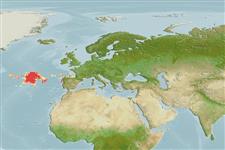इलाज़मौबरांकी (शारक और रेज़) (sharks and rays) >
Rajiformes (Skates and rays) >
Arhynchobatidae (Softnose skates)
Etymology: Bathyraja: Greek, bathys = deep + Latin, raja, -ae = a ray (Raja sp) (Ref. 45335).
Environment: milieu / climate zone / depth range / distribution range
पारिस्थितिकी
समुद्री बाथीड़िमरसल; गहराई सीमा 2400 - 2950 m (Ref. 3167). Deep-water; 47°N -
Northeast Atlantic: known from 3 specimens from the northern Bay of Biscay but distribution no doubt wider.
आकार / वज़न / Age
Maturity: Lm ? range ? - ? cm
Max length : 160 cm TL पुल्लिंग / अलिंग; (Ref. 3167)
A very rare species found on lower parts of continental slope and on adjacent deep-sea plains (Ref. 3167). Oviparous (Ref. 50449). Eggs have horn-like projections on the shell (Ref. 205).
Life cycle and mating behavior
Maturities | पुनरुत्पत्ति | Spawnings | Egg(s) | Fecundities | लार्वा
Oviparous (Ref. 3167). Paired eggs are laid. Embryos feed solely on yolk (Ref. 50449). Eggs have horn-like projections on the shell (Ref. 205).
McEachran, J.D. and K.A. Dunn, 1998. Phylogenetic analysis of skates, a morphologically conservative clade of elasmobranchs (Chondrichthyes: Rajidae). Copeia 1998(2):271-290. (Ref. 27314)
IUCN Red List Status (Ref. 130435)
Threat to humans
Harmless
Human uses
साधन
Special reports
Download XML
इंटरनेट स्रोत
Estimates based on models
Phylogenetic diversity index (Ref.
82804): PD
50 = 0.5000 [Uniqueness, from 0.5 = low to 2.0 = high].
Bayesian length-weight: a=0.00513 (0.00253 - 0.01042), b=3.12 (2.95 - 3.29), in cm total length, based on LWR estimates for this Genus-body shape (Ref.
93245).
Trophic level (Ref.
69278): 3.6 ±0.50 se; based on food items.
लौटाव (Ref.
120179): निम्न, न्यूनतम जनसंख्या दुगनी होने का समय 4.5 - 14 वर्ष। (Fec assumed to be <100).
Fishing Vulnerability (Ref.
59153): Very high vulnerability (90 of 100).
Nutrients (Ref.
124155): Calcium = 2.51 [0.35, 50.64] mg/100g; Iron = 0.244 [0.023, 3.282] mg/100g; Protein = 14.1 [12.3, 16.1] %; Omega3 = 0.375 [0.141, 0.985] g/100g; Selenium = 24.8 [4.2, 110.9] μg/100g; VitaminA = 3.62 [0.24, 50.82] μg/100g; Zinc = 0.261 [0.017, 3.236] mg/100g (wet weight);
